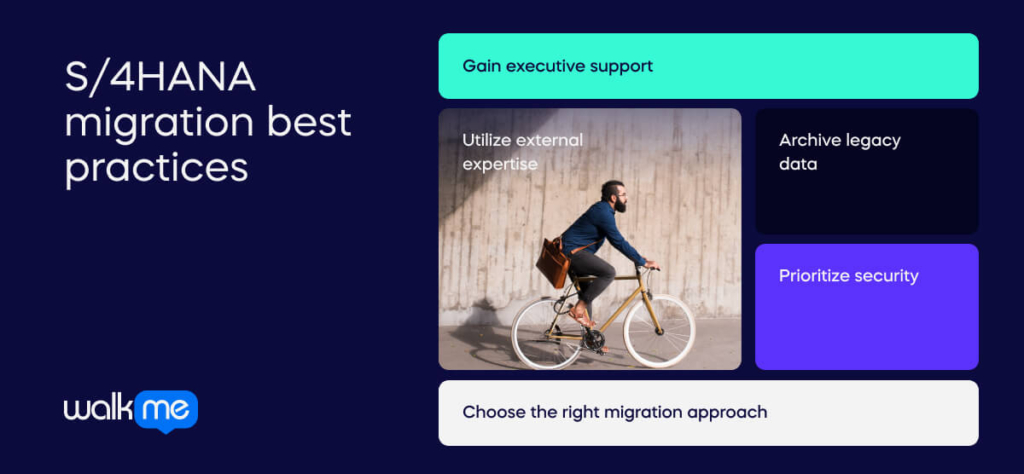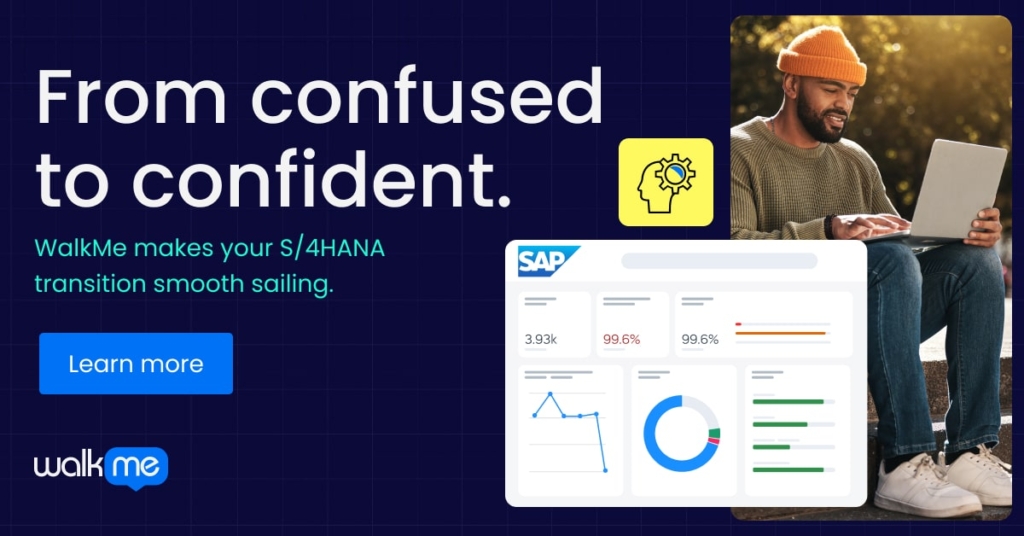It mandated SAP ERP users to transition to S/4HANA by 2025 as part of a new digital ecosystem.
S/4HANA is a newer version of SAP that allows users to process real-time data for optimized decision intelligence using the latest data.
Of the companies that have begun implementing S/4HANA, 25% are in live deployment and 25% are in the proof of concept stage, while 25% have a roadmap for S/4 transformation. So, the statistics show that leaders would be careless to assume other organizations are lagging behind with S/4 migration.
The importance of migrating quickly is why we cover when you should migrate to S/4HANA, why, the best approaches to S/4HANA Migration, and the benefits and challenges.
This information will help you understand the significance of starting your migration immediately.
When should you migrate to S/4HANA?
Before you begin your migration, it’s essential to consider timespans and the best time to start the process that will give you digital resilience for the future.
Numerous entities extend beyond this timeframe to entirely switch to SAP S/4HANA. Occasionally, intricate migration phases consume the entirety of the anticipated project duration.
Given the uncertainty of the migration path, it’s prudent to initiate the move to a suitable ERP solution as soon as possible.
Commencing the migration process sooner facilitates ample time for the organization to execute the transition and cut costs.
Why should you migrate S/4HANA?

Understanding the motives behind migrating to S/4HANA is crucial as it enables informed decision-making.
Recognizing these reasons helps businesses effectively leverage the platform’s capabilities, ensuring seamless transitions and maximizing the benefits of this advanced ERP solution.
And let’s not forget the obvious point: Regular SAP will not be available in a few years! So now is the time to migrate.
SAP has mandated the migration
The most apparent reason to migrate to S/4HANA is that organizations will no longer have a choice of tool by 2027. Many organizations will ask themselves, “Do we want to migrate early or late?”
The answer is that there are only benefits to early migration and disadvantages to migrating late.
It’s helpful to consider the migration and how to accomplish it in the shortest time to prevent delay, frustration, and even possible negative impacts on your employee retention in the future.
All companies might delay
Numerous businesses operate on ECC (SAP ERP Central Component), like Infosys, Fujitsu, and Panasonic. Many of them might opt to wait until 2027 for migration, potentially causing a shortage of skilled SAP personnel.
This scarcity could inflate the cost of such resources, even if they are available. Plus, given SAP’s current market dominance, those exploring alternative software may encounter similar resource constraints from other ERP vendors.
Transitioning to SAP S/4HANA isn’t a simple choice. Delaying this shift could lead to conflicts with other organizations. SAP resources already engaged in migration projects may not have the capacity to assist with yours or may prioritize more lucrative opportunities, leaving your business at risk.
Given the complexity of system conversion, you should transition sooner rather than risk becoming a victim of the migration rush around 2027.
Avoid Disruption
A last-minute rush to migrate to S/4HANA can result in quality issues, oversights, business disruptions, and challenges in change management.
Managing many enhancements and internal conflicts can be challenging for businesses. Successful large-scale migration demands thorough planning, data-driven analysis, and adequate time and resource allocation.
Currently, you have the flexibility to plan the process meticulously, manage existing systems, establish backups, address potential pitfalls, and execute the overhaul more smoothly.
A less hurried migration to S/4HANA, without the pressure of an imminent deadline, is more likely to succeed without compromising quality.
Insufficient SAP or alternative ERP resources
The current pool of qualified and experienced resources may not be adequate to handle such a significant shift. As the deadline approaches, finding knowledgeable consultants for a successful SAP S/4HANA migration becomes increasingly challenging.
While efforts like Applexus’s initiative to train future consultants are underway, a shortage of SAP experts could impede or delay successful transitions to SAP S/4HANA or alternative software, given SAP’s market dominance.
Surge in consultant fees
A rushed migration at the last minute will lead to a scarcity of skilled consultants. Knowledgeable consultants and experts may not be readily available to facilitate the SAP S/4HANA transition.
The shortage of quality resources will drive demand and rates for consultants with the requisite skills. Aware of the market, consultants are likely to increase their rates, posing financial challenges to businesses and preparing for potential decreases in project availability once most organizations have migrated.
Future-proof your IT investment
Embracing SAP S/4HANA sooner enables the modernization of your business ecosystem. Continuing to invest in legacy ERP systems, with customization and development, may hinder progress.
SAP is actively investing in S/4HANA while phasing out support for SAP ECC. Aligning both solutions in the long term isn’t feasible. Future-proofing your systems and processes is essential. With SAP’s focus on innovation and value delivery, sticking with a regressive system poses risks and offers fewer rewards over time.
Avoid redundant investments
Reconsider investing in hardware or hosting solutions for your current SAP system. Spending significantly on an outdated system may not yield substantial returns in the long run.
Upgrading to S/4HANA Cloud (public/private) eliminates the need to maintain the current setup and avoids additional expenses when transitioning to S/4HANA in 2027.
As you can see, several reasons exist to begin your migration today. It’s essential to start planning now to avoid all the drawbacks, such as lost resources and possible staff.
Early migration streamlines your use of the new S/4HANA system and can give you the competitive edge thousands of companies are already working towards.
What are the best approaches to S/4HANA Migration?
The appropriateness of S/4HANA migration strategies differs for each organization, and there is no universal method. Some choose a greenfield approach, starting anew, while others favor a brownfield approach involving a complete system conversion to minimize disruptions to current business processes.
The hybrid approach is ideal for those aiming to streamline their system landscape into SAP S/4HANA, leveraging the advantages of greenfield and brownfield implementations. This tactic is particularly effective for large enterprises managing vast data and intricate systems.
Here are three approaches for SAP ECC migrations to S/4HANA.
Greenfield Approach
The greenfield or re-implementation approach allows organizations to revamp outdated processes with the latest S/4HANA innovations. It suits those requiring a fresh SAP S/4HANA implementation, leveraging their existing ECC system as a legacy. However, the substantial changes involved may unsettle some.
Re-implementation can be demanding and time-intensive, especially when effectively managing change. Hence, thorough preparation is crucial for undertaking the rigorous and exhaustive re-engineering process associated with the greenfield approach.
Brownfield Approach
The brownfield approach, also known as the upgrade approach, entails migrating databases and converting applications. It suits organizations relying on legacy systems like SAP R/3 or ECC, content with current data management and business processes but seeking swift innovation adoption.
This method facilitates the transition from SAP ECC to S/4HANA by converting the existing SAP environment without overhauling current business operations.
Despite the risk of technical issues during and after conversion, SAP provides specialized conversion tools and guidelines to manage and mitigate potential problems from inception preemptively.
This proactive approach ensures a smoother and more efficient migration process for organizations opting for the brownfield strategy.
Hybrid Approach or Selective Data Transition
Selective data transition involves technical migration at the table level, employing preconfigured transformation rules to extract specific master and transactional datasets. This method allows organizations to establish new configuration settings, enhancing business processes.
For instance, organizations can apply selective data migration to S/4HANA by configuring various organizational elements, like legal entities. It also permits retaining historical data, enabling organizations to convert and adapt it to align with a new S/4HANA configuration.
S/4HANA migration best practices

S/4HANA migration best practices are crucial for ensuring a smooth transition to the new ERP system. They also help you minimize risks, maximize efficiency, and optimize resources. Following these best practices will result in successful adoption.
The first best practice is to gain executive support, as this will result in consistency and positive outcomes as the migration progresses.
Gain executive support
Persuading employees and stakeholders to embrace a complex project like S/4HANA migration can be challenging. IT leaders, CIOs, and CFOs may express concerns regarding costs, efforts, and risks. However, migration initiatives are often necessary to adapt to evolving business needs.
Organizations should view migration as a company-wide strategy rather than a tactical project. Everyone in the organization must comprehend the strategy thoroughly to ensure adequate planning and execution. Management should devise a roadmap that IT and business teams can understand and endorse.
Utilize external expertise
Migrating to S/4HANA poses numerous challenges, and many organizations lack the internal expertise required for a seamless transition. Consequently, innumerable businesses collaborate with external migration experts to assist with various aspects of the migration process, including workload assessments, planning, process mapping, implementation, and management.
While internal IT support is vital, consulting with external specialists often yields additional business benefits. However, effective collaboration between external and internal teams is paramount to success.
Choose the right migration approach
Before commencing SAP S/4HANA migration, organizations must make critical decisions regarding the overall migration strategy. Different approaches may be more suitable depending on the specific S/4HANA systems (e.g., on-premise vs. cloud).
To avoid future issues, it’s also essential to weigh the option of simply converting data and settings from the existing ECC system against establishing an entirely new SAP ERP system. Successful migration hinges on thorough planning guided by a clear strategy.
Archive legacy data
A pivotal preparatory step for businesses transitioning to SAP S/4HANA is archiving legacy ERP custom code.
Research indicates that a significant portion of ABAP code is customer-specific and often remains unused after creation. Conducting this clean-up before migration presents an excellent opportunity to optimize the ERP system, leading to reduced migration volume and lower financial and time costs.
Prioritize security
Given the evolving business application threat landscape and the increasing sophistication of threat actors, integrating security from the outset of transformation projects and application development is imperative. Neglecting SAP security at the application level can result in significant business impacts you cannot ignore.
By adopting a “shifting left” approach, which entails incorporating security validation during code creation rather than deployment or testing, enterprises can proactively prevent potential risks from materializing during production or escaping the development environment altogether.
This proactive stance enables businesses to identify and address security issues early, mitigating the risk of security breaches and their detrimental consequences.
Focus on the mandate to drive your S/4HANA migration
There are many reasons to migrate to S/4HANA.
High fees for consultants nearer the mandate, avoidance of disruption through early migration, the chance other organizations may be migrating late, and the competitive edge you can enjoy are just a few of these incentives to migrate early.
However, the most apparent reason to migrate is that there has been no choice but to do so since SAP announced the mandate!
S/4HANA is inevitable, so you should begin the migration as soon as possible to avoid being high and dry scrambling to a new tool that thousands of other companies are already confident in utilizing.
Begin your S/4HANA migration today to gain a competitive edge and increase revenue as your digital adoption streamlines workflows and helps you rise to the top.


